What I'm about write about might make me seem to be an expert mathematician, well don't be fooled, I'm not! My teachers never thought so. I can do arithmetic, plain old adding, subtracting, dividing and multiplying, but not the other fancy stuff, just never got it. All the information I've used can be found on the internet.
When you start photographing really tiny flowers, you have to get real close, down on your hands and knees, (getting down is the easy part) these close-up photos reveal things you would not usually see. You see intricate design!
Click to enlarge.
Look carefully at the florets in this flower and see the spirals, these spirals are known Fibonacci spiral, and you find them everywhere in nature. If you enlarge this photo you will see the minute insects that call it home. Why were these tiny flowers, which most people would never see, made so perfect and beautiful? And with most of them it's literally here today gone tomorrow.
This illustration that I downloaded from the internet, shows clearly how these spirals look. The numbers 21 and 34 are known as Fibonacci numbers. A daisy for instance has 34 petals, I haven't counted them personally.
Fibonacci number sequence: 1, 1, 2, 3, 5, 8,13, 21, 34, 55, 89, 144,... .
Another Fibonacci number is the number five, count the stamens on these tiny flowers, (the camera lens was millimeters away from the flower) there are five on each one. This delicate little flower brings to my mind a ballerina dancing.
Every one of these tiny flowers has five petals.
Drawing of a Fibonacci spiral. The rectangle within which the spiral fits is called the "golden mean".
Fibonacci spiral in a spiral galaxy.
In a nautilus shell.
In a hurricane.
The Parthenon in Athens Greece is the most famous man-made examples of the "golden mean".
Who or what was Fibonacci? Leonardo Fibonacci (1170 - 1240), was a mathematician, the most renowned mathematician of his day, who lived in Pisa Italy.









3 comments:
Phew, that's profound!
Ah, the golden mean. I was quizzed about it once by a math teacher to see if I, an art teacher, did understand it. I never did for a long time as it never made it in any of my college art classes. I did see the design that it makes and the shell design is always used as a decoration. Thanks for the info.
Well, that was my learning curve for today. Next time out, I will take a closer look at the flowers I run across. Interesting stuff.
Post a Comment